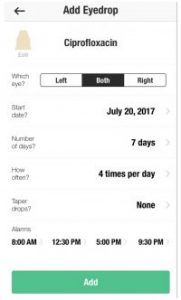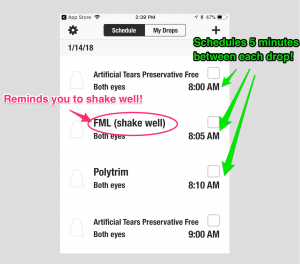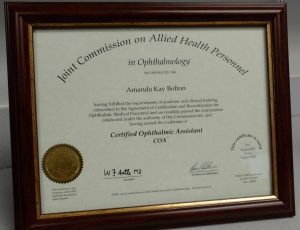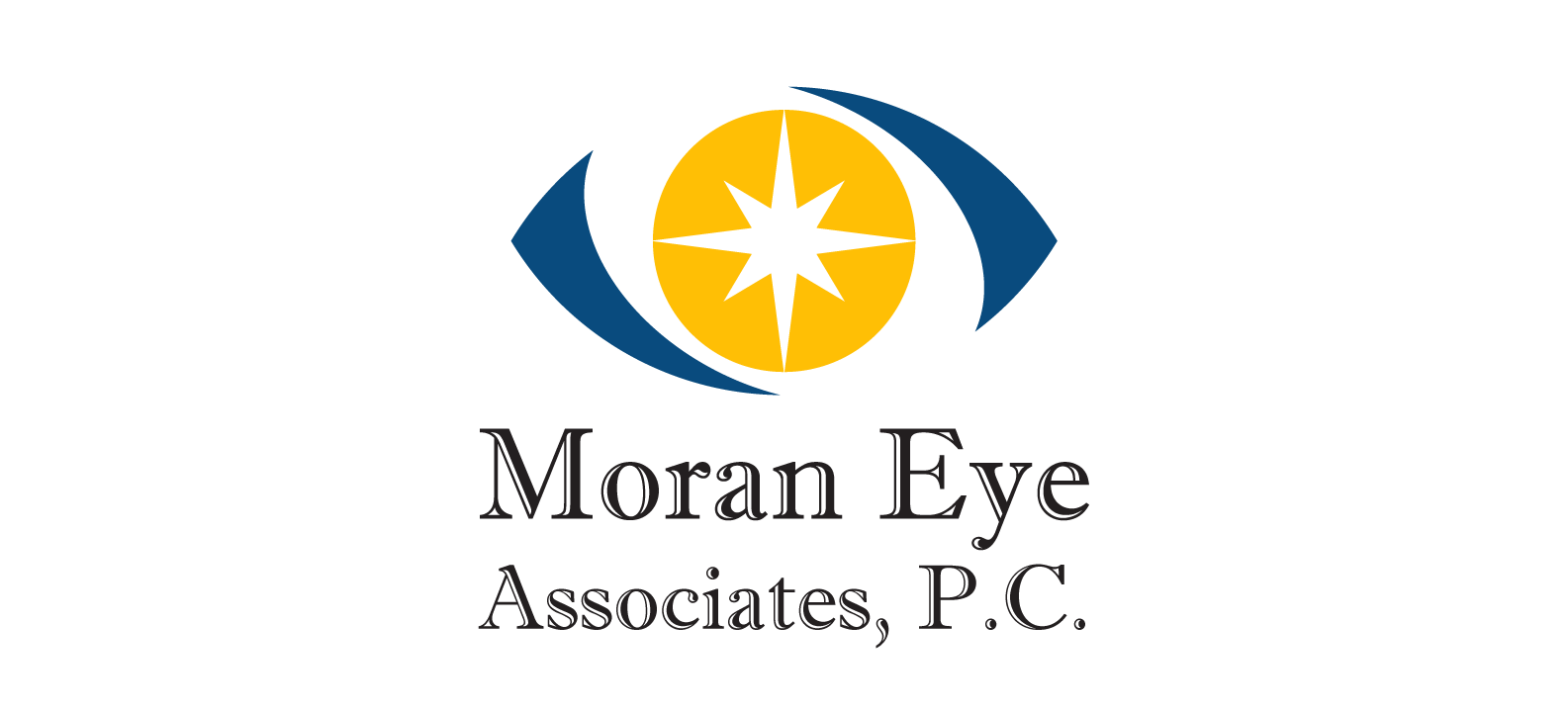by Dr. M | Jan 15, 2018 | Education, LASIK, Medical Eye Care, Patient Care, Procedure, Surgery
To help maintain your great vision after LASIK, the use of eye drops is key. A patient recently shared a smartphone alarm app with us that reminds you to use your eye drops regularly!
LASIK surgery is a high-tech procedure that improves your vision in about 20 minutes. The laser application itself takes just seconds.

The Eye Drop Alarm keeps you on track with your medications.
But LASIK is much more than just a quick LASER treatment to the eye. Pre-Operatively, there are multiple exams, measurements, interviews, and calculations.
The Post-Operative period is also important to a successful, stable outcome. We consider the postoperative period to be ONE YEAR.
During this year, Dr. Moran highly recommends that patients use a rigorous schedule of artificial tears. Patients who follow this post-op protocol, do better, heal faster, and have less chance of their vision changing for the worse.
Using eye drops after surgery does a number of things:
- Prevents Infection
- Decreases Inflammation
- Provides Added Moisture
- Aids in Healing
Remembering to take your drops the first week is easy.
Seeing without glasses or contacts is an amazing change. Patients are enthusiastic and stay on top of their drop schedule. As more time passes, patients may not think about their new vision as much. Although the newness of the better vision wears off, the need for drops doesn’t!
Studies have shone that your eyes may need supplemental moisture for more than three months after the surgery. Even though the eyes don’t feel dry, they need the added moisture to maintain quality tear film and to provide the best visual result.
The Eye Drop Alarm smartphone app is a great way to help you keep up with your drop schedule:

Eye Drop Alarm
A patient recently showed us an iPhone app he downloaded (iPhone only at this point, sorry Android users.) The app is free for download, well written, easy to use and comprehensive.
The full description can be found at http://www.eyedropalarm.com/ The app is free and requires no login or personal information. It has a full database of eye drops, even those used for other eye problems like glaucoma.

Special instructions too!
The features are useful and extensive. As seen in the illustration, this app also indicates if the drops need any special instructions, for example, the FML should be shaken before use. Using multiple drops requires you to wait five minutes between each different drop so that the eye can absorb each medicine…the app automatically schedules each drop 5 minutes apart!
If you have an iPhone and have to take drops, we highly recommend EyeDropAlarm. You can download the app by scanning this QR code or through iTunes.

by Dr. M | Jan 8, 2018 | Cost, Education, Exam, LASIK, Mark Moran, Medical Eye Care, Patient Care, Surgery

Dr. Mark Moran has been doing LASIK for almost 20 Years.
I’ve been doing LASIK surgery since the turn of this century, so I keep up on LASIK news. I hadn’t seen deeply discounted LASIK at unbelievable prices in quite a while. But recently, I have started to get emails offering me LASIK at $299 per eye.
As a physician practicing in today’s environment, I have a responsibility to ensure my patients are getting a fair price. When an EpiPen can cost $500, and drug prices can increase from $7.50 to $750 overnight, I must make sure that I consider price options when making recommendations for my patients.
In the past, knowing what it costs to operate a LASER and the cost of performing a safe and accurate LASIK procedure, it was evident that there weren’t many LASIK surgeries being performed at the advertised price of $299. It costs far more than $299 for the doctor to perform LASIK, not to mention the equipment costs for accurate testing and measurements.
I had been told by patients who had investigated the $299 LASIK offer, that the $299 LASIK wasn’t available for them. It seems as though $299 was just the starting price. The cost escalated soon after the consult started. This was second-hand information so I never really got the specific facts until now…
Recently I got an email offer which finally included the “fine print.” I’m going to break it down.
Following is a breakdown of the disclaimer on their low-cost offer:
“Prices based on prescription: up to -1.00 $299,”
The first phrase in the disclaimer is the main reason why so few $299 LASIK procedures are done. A -1.00 prescription is probably about 20/40 vision. You would still be able to drive an automobile both during the day and night. (There are stronger restrictions for nighttime driving.)
The pricing detail continues:
“…-1.25 to -2.0: $1099;
…-2.25 and up as well as all hyperopic and/or greater than -0.50 diopter of astigmatism: $1799.”
Then the other shoe drops. If you have a half of diopter of astigmatism that raises the price to $1799, which is now approaching a reasonable price for a standard LASIK procedure. Seventy percent of all prescriptions written in America have some astigmatism. Which means if there if there is a significant enough prescription that needs correction and one is given, three-quarters of the time it’s going to have astigmatism. The price has now hit the $1800 per eye mark.
“Individual results will vary.”
I got a chuckle from this portion of the disclaimer. Pretty obvious observation.
“Candidacy determined by an independent doctor located within or adjacent to the LASIK Vision Institute’s (LVI) facility. All procedures performed by an independent surgeon. Punctal plugs, assurance plans and other technologies available at additional cost. This offer may not be combined with other offers. Other conditions may apply.”
And then there’s the “additional cost” disclaimer. So even with the maximum quoted price of $1799 there are still add-on charges to consider.
The take-home message: you’re not likely to get LASIK (or do you need LASIK) at $299. There may be small variations in price for LASIK surgery by area doctors, but the costs for procedure tend to be similar.
The smart consumer considering LASIK surgery should be looking for other factors in making their decision. Choose your surgeon based on:
- Level of Experience,
- Successful Patient Outcomes,
- Equipment and Technology Used,
- Patient Satisfaction & Reviews,
- Overall Quality of Care.
caveat emptor.
by Dr. M | Oct 24, 2017 | Education, Experience, Mark Moran, Patient Care
 Mark E. Moran, D.O., M.S.H.I., F.A.O.C.O
Mark E. Moran, D.O., M.S.H.I., F.A.O.C.O
Dr. Mark Moran has added another degree to his already impressive set of academic accomplishments. He recently completed a Master of Science in Health Informatics (MSHI) at Drexel University. We are very proud of our graduate!
This area of study provides knowledge of how to use information technology efficiently and responsibly to improve health outcomes.
Dr. Moran explains why pursuing this degree was important to him.
“I’ve always had a dual career in both medicine and computers. I pursued my medical degree to allow me to practice medicine. At the same time, I continued my computer career without an official degree. The online Drexel program allowed me to formalize that computer experience, without taking time away from seeing my patients. With the integration of computers and informatics in medicine today, the two career paths have merged into one.”
As a practicing physician, Dr. Moran brought a unique first-hand perspective to his course of study. He was able to apply his knowledge directly to his practice, Moran Eye Associates, in Bethlehem, PA. Now, his patients benefit not only from his medical experience, but also from his awareness of how healthcare information can be managed and shared for better patient care.
This newly accredited Drexel program was developed with the following mission statement:
The mission of the MSHI program is to advance national healthcare goals by preparing health informatics professionals to exercise leadership in an increasingly patient-centered and data-driven environment.

Dr. Moran is a Drexel University Graduate
The program pursues this mission by offering an interdisciplinary, broad-based curriculum that encourages engagement with industry and fosters both research-based and experiential learning.
For more information on this degree program, click to visit the Drexel University website: Drexel University MSHI
by Dr. M | Sep 13, 2017 | Education, Exam, Experience, Office, Patient Care
We congratulate Mandy Bolton on achieving her Certified Ophthalmic Assistant (COA) designation!

Mandy

The COA professional certification is provided by (JCAPHO), the Joint Commission for Allied Health Personnel in Ophthalmology and is an industry-recognized achievement.
Mandy’s COA accomplishment is not her first professional achievement. She was also the first Certified Patient Services Specialist in the state of Pennsylvania, completing that program in 2013. Her educational achievements highlight her dedication to providing the best patient care.
What is a COA?
The Certified Ophthalmic Assistant (COA) is a core designation for eye care professionals on the path to success. This designation confirms an assistant’s knowledge in 19 specific content areas. The COA certification examination is three hours in length and is comprised of 200 scored multiple-choice questions.

Many hours of textbook study goes into preparation for this demanding test. Mandy was also fortunate to have hands-on experience working with patients and learning from Dr. Moran to help supplement her course of study. Dr. Moran is proud of her dedication to our practice and to our patients.
When you see Mandy, please be sure to congratulate her on her achievement!
by Dr. M | Sep 5, 2017 | Appointment, Education, Exam, LASIK, Medical Eye Care, Office, Patient Care
At Moran Eye Associates, patient education is a priority. Our goal is to make sure that you see clearly AND that you understand clearly as well!
Have you ever left a doctor’s office and not been completely sure about your diagnosis or treatment plan? We never want that to happen to you at our office! Dr. Moran is an expert at patient education. He makes complex medical information easy to understand by using analogies. We’ve compiled a “Best of” collection here. Our patients appreciate how he explains the sometimes confusing issues of eye care!

A peep hole in a wooden fence.
If you want to see what’s on the other side of a fence, the bigger the fence hole, the more you can see. When patients ask why they have to be dilated, this answer helps make it easier to understand. If Dr. Moran is looking through your normal pupil he/she will only see a small portion of the back of the eye. If he is looking through a dilated pupil, the hole is much bigger, and he can see much more to better evaluate the health of your eye.
Your eye is like a camera. The retina is like the film of the camera, and the eye’s lens is like the lens of the camera. In order to have good photos (clear vision), both the lens and the retina must be working well. You won’t have a good photo is there is a problem with the film…just like you won’t have a good photo if the lens is damaged.

Tear film is like rain on a windshield
Tear film is like rain on a windshield. If it is only drizzling and there is very little rain (poor tear film), your windshield will be streaky, the wipers won’t work effectively, and your vision will be blurry. If it is raining steadily (good tear film), the wipers will clear away the water effectively and your vision will be clearer. Your eye works the same way…good tear film is needed for clear vision.
You don’t need a bazooka to swat a mosquito. When Dr. Moran prescribes medicine, he chooses the right medicine for your needs. There are many options available, so it’s important to have the right dosage of the right medicine, more is not always better!

Cruise Ships turn very slowly!
Changing treatment plans is like turning a cruise ship, turn gradually and you will get you where you need to go smoothly. If you are moving from one treatment plan to another, we don’t want to make abrupt changes. Making gradual changes can help to achieve the best results.

Make sure the fire is COMPLETELY OUT!
When you put out a fire, make sure it is out completely. If you leave embers burning, it may reignite! It’s a good way to understand why you need to continue taking all of your medicine. If you stop taking it before the pain is gone, or before the infection is completely gone, your problem could start up again. Think of it like a fire that reduced to embers, it can burst into flames again!
Dr. Moran is always coming up with new and different analogies to make vision care less confusing. We’ll continue to update our patient education “best of lists” on Facebook! “Like” Moran Eye Associates us to stay informed!
Moran Eye Associates on FB






 Mark E. Moran, D.O., M.S.H.I., F.A.O.C.O
Mark E. Moran, D.O., M.S.H.I., F.A.O.C.O






